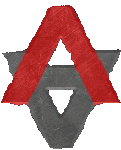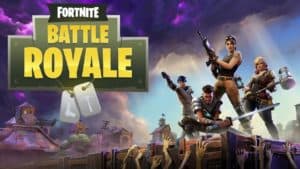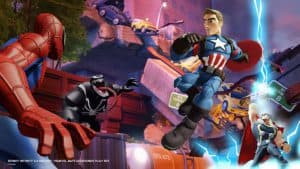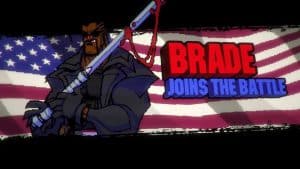Platforms Xbox One, PlayStation 4, Windows PC Genre First Person Shooter, MOBA
Platform Played Xbox One
Publisher 2K Developer Gearbox Software
Battleborn is a first-person shooter that adopts MOBA mechanics such as laned maps, minion pushing, and restarting the levelling up process each match. The result is a unique game for both genres. The multiplayer game modes offer a nice twist on the traditional MOBA formula, the playable characters are balanced and diverse, and the art style is beautiful in its chaos. However, the story mode is a repetitive slug thanks to boring enemy tactics and similar objectives.
It’s almost immediately evident that Battleborn is developed by the same studio that brought us the Borderlands franchise. While gameplay is slightly different, the mechanics have a Borderlands feel. The shooting is mostly solid, but it does have that slightly floaty feel of Borderlands – particularly with a gamepad. It still feels great, and actually balances out the sniper champions like Thorn and Marquis by making it harder, but more rewarding, to land their high damage dealing attacks. The dialogue and narrative of Battleborn’s story mode are also distinctly Gearbox. It’s a story about the universe being on the verge of destruction, but it doesn’t take itself too seriously. The writing is witty, the characters are silly, and the whole thing has the feel of a Saturday morning cartoon. I found myself laughing quite a few times throughout missions. This dialogue carries over to the playable characters, and even the multiplayer announcer who says things like “time to kill noobs in 3, 2, 2”.
However, the story missions are lacking fun gameplay. The missions are all similar, requiring you to fight your way through groups of enemies to reach an objective. At first it’s enjoyable running through hordes of enemies with four other players because of Battleborn’s fun shooting mechanics and each heroes’ unique play-style. However, it gets repetitive quickly. I never played more than one story mission in a sitting because I didn’t want to commit myself to 30 to 40 more minutes of the same enemies. The only tactics enemies have is to run at you and overwhelm you with numbers, or shoot at you from a distance. The only difference between the difficulties is that the enemies are more aggressive and there are a few different enemy types introduced.
Furthermore, if you are playing Battleborn‘s story missions solo, it’s near impossible to use some characters because they are not designed to kill large amounts of enemies by themselves. Playing with a team of five is much more fun, but when using the matchmaking function players quit if a mission is selected that they have already done. You also can’t matchmake on the advanced difficulty, and normal does not offer as much of a challenge for a team of five.
On the other hand, multiplayer is where Battleborn shines, and where most players will spend their time. It’s also where Battleborn’s MOBA traits take full flight. Battleborn takes MOBA elements like pushing minions down lanes and destroying towers, but them breaks them up into interesting new game modes, and places a 30 minute time cap on matches – although most are done before the time limit. Incursion features one lane and requires teams to push minions along the lane to destroy two enemy spider tanks. You can kill neutral monsters on the map to recruit them to fight on your side, and build structures like turrets and health stations to give your side an advantage. Meanwhile, Meltdown features a two-lane map with teams pushing their minions towards incinerators that eat the minions and score points for your team, with the first to 500 claiming victory. Both game types feature the core MOBA elements, but they are expressed in fun new ways that are accessible to newcomers, but also offer deeper strategy for experienced players. Meltdown was my favourite because it provided more of a tug-of-war, with teams frantically rushing to kill opposing minions before they got to the incinerators. Incursion matches were often one-sided affairs because of the single lane structure.
In multiplayer, no player on the same team can pick the same character. Battleborn‘s diverse selection of playable characters means this isn’t an issue. There’s a nice mix of ranged and melee characters, as well as damage dealers, tanks and support characters. I was surprised how enjoyable melee characters are from the first person perspective, with melee strikes carrying weight thanks to great sound design. In fact, almost every character is fun to use and each one has unique abilities that encourage different play-styles. From Thorn’s powerful bow and arrow that acts as a sniping class, to Rath’s swordskills and knock-up, to Benedict’s aerial movement and rocket launcher, Battleborn’s diversity is great. The hardest part about starting a Battleborn match was choosing which character to use.
Battleborn‘s Helix levelling up system adds even more variety to matches. Rather than choosing which skill to improve upon levelling up, Battleborn asks players to choose between one of two or three upgrades to their character each level. For example, you might have to choose between gaining more attack damage, or adding an amplifier to one of your character’s abilities. Or, in Orendi’s case, you might have to choose between giving her Shadowfire Pillar ability area of effect damage, or the ability to cast it twice in quick succession.
The Helix system
It’s a great system because it made levelling up more dynamic as I made upgrades based on the current game situation rather than a set levelling pattern. If I was landing my rocket shots with Benedict, then I’d consider giving my rockets more damage at the loss of blast radius. However, if I wasn’t landing many rocket shots, I’d make the other choice. Your character’s maximum level each match is 10, so there are 10 different choices to make each game. Even if you keep choosing the same character you can make slight tweaks each match to slightly alter your play-style.
Despite the diverse range of characters, most of them are locked until you reach a certain account level, or complete a specific challenge associated with them. For example, you unlock Ghalt at rank 40 or by earning a silver rating on all Story missions on Advanced difficulty. I’ve played for about 20 hours and have only unlocked 18 of the 25 characters available. For a game that requires 10 different characters to be used in a match, it seems counter-intuitive to restrict access to some, especially when they shouldn’t be any more powerful than the other characters because the gameplay has to be balanced. This is a full priced game, not a free-to-play title whose monetary model depends on free champion rotations.
On the technical side, Battleborn looks absolutely stunning. The cel-shaded art style makes colours pop on the screen. The game sounds great too, with each character’s attacks and abilities having their own sound effects. Abilities flying over the screen look spectacular, but at times the action can get too chaotic to adequately work out what is happening from a first-person perspective. This is especially true of the Incursion game mode because all 10 players are squished together in the same lane. After many hours of play, you begin to identify what certain skills are, but it’s an issue for new players.
Server wise, I didn’t have any problems with connecting to games, but I did have an issue with finding matches that gave me three bars of latency. Even playing during prime-time hours in Australia, I always had a yellow or red latency bar in multiplayer. While it didn’t effect my experience too much, I sometimes felt that my melee attacks that should have been registering were not.
Battleborn is an enjoyable first-person shooter that makes smart use of MOBA elements to create a unique multiplayer experience, but an average story mode. The art style looks wonderfully colourful, the playable characters feel balanced, and the multiplayer modes are carefully thought-out and a joy to play. Despite featuring a fun, humorous story line, the story missions are made lacklustre due to boring enemy tactics and drawn out boss fights. I felt no need to replay them once I’d finished them. The character unlocking system could use some tweaking, and there is sometimes too much happening on-screen to keep track of, but it didn’t effect my experience too much. If you’re a multiplayer shooter or MOBA fan and are looking for something new and different, I recommend you try out Battleborn.
The Good
- Smart incorporation of MOBA elements into a first person shooter
- Fun multiplayer game modes
- Diverse character choice
The Bad
- Repetitive story missions and boring enemy tactics
- Character unlock system
- Art style makes the gameplay too chaotic at times for first person perspective



